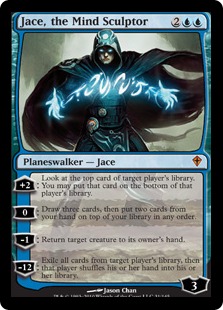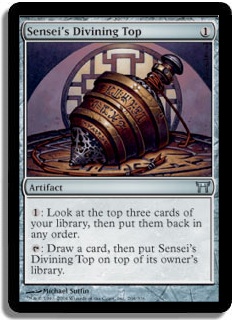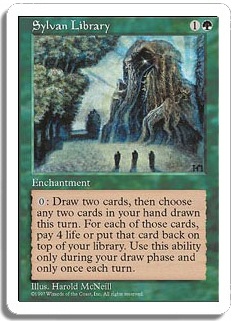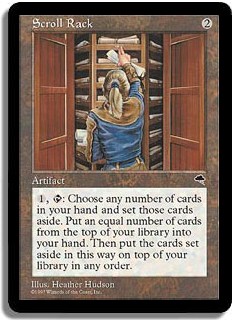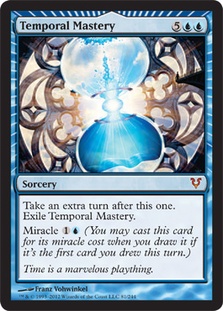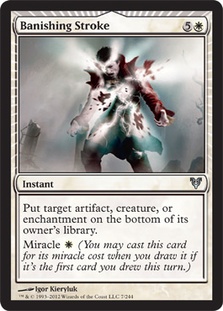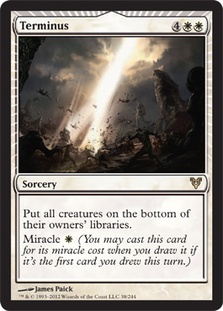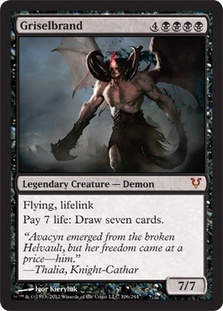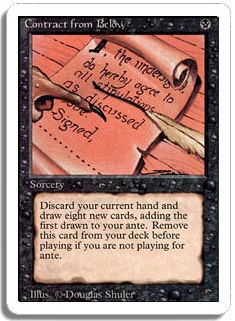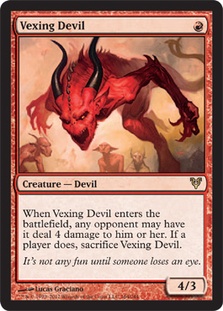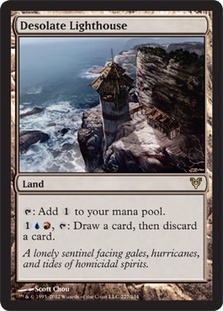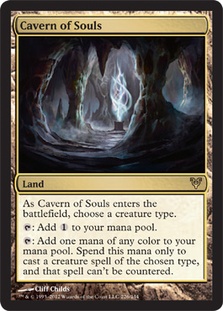It’s that time of the year again; the complete spoiler for a brand new Magic: The Gathering set is up online for us to examine, the subsequent Prerelease and release events are upon us, and very soon all of these neat new toys will be legal for Constructed play. Innistrad Block has had a deep and far-reaching effect upon every Constructed format, especially Eternal formats, which because of the depth of the card pool often don’t get a ton of new splashy cards to shake things up.
So far, Innistrad Block has given us such hits as Snapcaster Mage, Grafdigger’s Cage, Stony Silence, and Thalia, Guardian of Thraben, all of which have contributed to major shakeups in the Vintage metagame.
“Even before Avacyn Restored becomes legal, Innistrad Block has already left a significant imprint upon Vintage.”
After checking out the Avacyn Restored spoiler, I’m not convinced that there is anything in the set that is going to be as big of a deal as Snapcaster Mage or Grafdigger’s Cage for Vintage, but nonetheless there are a few cards that I think are going to see some play and contribute to the complexity of the Vintage format and its constantly evolving metagame.
Oh, and one card that might be the most important Vintage printing of the entire block…
So let’s delve right in.
Initial Perceptions of the Miracles from Motown
I’ve been playing Magic pretty much forever and since pretty much the beginning of the game. In many regards, I’m a purist and very conservative when it comes to what I want out of Magic and how I want my games to play out; I like games where battling back and forth over incremental advantages is what leads a player to victory or defeat. I am skeptical of power creep, I am wary that tempo is becoming too important, and I don’t like cards and strategies that I perceive as high variance.
“This is the kind of Magic card I don’t like to exist: a high variance, tempo card.”
Delver of Secrets is exactly the kind of Magic card that frightens me to exist, because it is intrinsically both high variance and pushes the boundaries of what other people can do because it is such a powerful tempo card.
With that being said my initial response to seeing the miracle mechanic, as you might have guessed, was not pure glee and delight. I don’t like the idea of getting some ridiculous effect on the cheap simply because the card was on top of my deck. Yet, I can’t help but feel that a big part of my initial aversion to these cards is more based on principle than upon feeling that any of these cards is actually too good.
Truth be told, after looking at most of the miracle cards, the reason that I dislike them is that most of them are not the type of card I would probably play with. This is because I don’t think the odds are good enough to try and get the high variance upside. Many people have already done the math on these cards, so I’m not going to bother wasting everybody’s time with that here by reiterating it. But it pretty much goes without saying that the miracle cards basically suck when one doesn’t “miracle” them, which leaves a lot of opportunities to draw cards that suck.
It probably won’t make it any easier to swallow when playing Standard and having an opponent make a “miraculous” comeback based on miracle cards. It’s always easier to see the upside, whereas you don’t, or can’t, always see how an opponent is losing because their miracle cards are being mediocre or dead in their hand.
All of that being said, I think it is possible that cards with the miracle mechanic are possibly more important in Eternal formats than they are in Standard, simply because there are more ways to enable or set them up. This means you are able to decrease the randomness and harness the power of these cards.
“I know, I know, everybody has thought about these particular things already. More importantly, the fact that EVERYBODY immediately came to the same conclusion probably tells us something…”
The thing with miracle cards is that because they are so completely different from anything else that has ever been printed, it is difficult for me to evaluate just how good they will be even with the plethora of ways to enable them. It becomes a question of how good is the upside compared to the times one can’t cheat them in relation to how consistently one will be able to set them up with the powerful enablers. Only time, testing, and data gathering will eventually show whether or not these types of cards will be good enough to be staples, niche players, or possibly even chaff.
Oh, and one more thing:
“Why is nobody talking about me?”
Scroll Rack is a very good card, and miracles increase its potential value in any Eternal metagame where it is legal. Maybe you should be looking to find a home for this card; Scroll Racking with miracle cards seems absolutely fantastic. If they only let you play one Brainstorm, sometimes you’ve got to take more drastic measures to put cards on top of your deck in any order…
Let’s examine some of the miracle cards that have potential to make waves in Vintage, starting with the flashiest and one I would vote “most likely to succeed.”
Temporal Mastery
“Voted Brian DeMars‘ Most Likely To Succeed: 2012″
A lot has already been written about this card, so I’m not going to waste people’s time in explaining what almost everybody already knows and understands. On the one hand, everybody talking about this card for non-Vintage formats is excited because it’s a build a Time Walk, which is obviously insane (since Time Walk is one of the most values in Magic for what you have to invest in it). But Vintage is full of insane cards already—I mean, we already are allowed to play with Time Walk…
“I would play five if the rules permitted, but thank goodness they don’t!”
Yet, let’s be honest: Temporal Mastery is no Time Walk, and it’s not even particularly close. Land, Mox, and Time Walk on the first turn is about as good as it gets in Vintage, while Temporal Mastery in the opening hand is likely to do very little without the one-of Brainstorm besides get pitched to a Force of Will.
I think that if Temporal Mastery is going to be better than good in Vintage, the place it is most likely to find a shell to play to the strength of the card is going to be a really big mana Tezzeret style deck.
Creatures (1)
Planeswalkers (5)
Lands (15)
Spells (39)
- 3 Sensei's Divining Top
- 1 Brainstorm
- 2 Mana Drain
- 2 Lightning Bolt
- 1 Vampiric Tutor
- 1 Mystical Tutor
- 1 Yawgmoth's Will
- 4 Force of Will
- 1 Scroll Rack
- 1 Mana Vault
- 1 Sol Ring
- 1 Demonic Tutor
- 1 Time Walk
- 1 Ancestral Recall
- 1 Mana Crypt
- 1 Time Vault
- 1 Thirst for Knowledge
- 1 Tinker
- 1 Voltaic Key
- 1 Black Lotus
- 1 Mox Emerald
- 1 Mox Jet
- 1 Mox Pearl
- 1 Mox Ruby
- 1 Mox Sapphire
- 1 Ponder
- 2 Mental Misstep
- 4 Temporal Mastery

This is just a rough sketch of what such a deck might look like, not really taking into consideration subtlety of the metagame. The features I believe would allow this deck to take advantage of a lot of Temporal Mastery(s) are: a lot of enabling, really big mana, a lot of planeswalking (Jace), and simply trying to run people over with powerful cards.
Also, the ability to tap Sensei’s Divining Top on the opponent’s end step to miracle a Temporal Mastery and take two full turns with a bunch of mana seems pretty sweet. Setting up that play is the one way where Mastery can actually be kind of better than Time Walk. Having to exile Mastery makes the card much fairer (not that Snapcasting back a seven-mana sorcery would have made too much of a noteworthy difference), and yet there’s nothing quite like Willing and Walking…
Honestly, I’m not super concerned or convinced that Temporal Mastery is going to be a huge deal in Vintage the way that Snapcaster Mage or Grafdigger’s Cage have turned out to be, but I do think that it may have a place. Legacy, where players are allowed to use four Brainstorm, is the place where it will likely really shine.
Moving along to the next Miracle…
Banishing Stroke
“If only there was some humorous thing I could say about Stroke or Stroking, but alas there is literally nothing…”
Banishing Stroke is a pretty interesting card, because if it was costed at two or three mana with no miracle cost it would almost certainly be Vintage playable. The pure utility of a card that can answer any non-planeswalker, non-shroud, non-land permanent would be invaluable in a format full of diverse threats.
It even passes the Blightsteel Colossus test!
If anything, I could see this card as the type of thing that some of the control decks might want to play as a one-of catchall kind of answer in the maindeck—especially if they are playing a lot of Tops to play Temporal Mastery and especially if there are a lot of Oath decks popping up. Banishing Stoke would have probably been better in almost any other color, since it’s going to be competing with Swords to Plowshares in most decks for a spot, and Swords is simply a much more powerful Magic card because it takes no effort to set up.
Terminus
“Somebody sound the Vintage Sleeper Playable Alarm, we have Terminus.”
I’m going to go out on a limb and say mark this card as my Sleeper Vintage playable card for Avacyn Restored. It’s not insane, but I think it is unique, powerful, and distinctive enough that it would be a reasonable card to play with in Vintage.
Wrath of God hasn’t been Vintage playable in a decade because it simply costs too much mana. However, the potential for a one mana Wrath of God makes me interested in evaluating what this card has to offer.
The problem is that not everybody is going to be able to use this card (which the same can be said for pretty much all of the miracle cards.
However, Top and Jace heavy decks might really love to play with this spell, and with Top there is a lot of upside to creating really, really big blowouts. One can actually end of their turn tap Top to draw and miracle cast Terminus to untap with a clear board. If one sets up this play, they are getting better than the equivalent of a 7CC cost spell (Route with kicker), which by the way will also kill a Blightsteel Colossus.
Whereas Temporal Mastery is a more obviously solvable card since even (and especially) people with literally no imagination can see why and how getting a cheap Time Walk is good, I believe that Terminus is actually a more powerful card because it does something much more unique and is an effect that a lot of decks might actually be looking for.
Thunderous Wrath
“Five damage for one mana; somebody will want to do this, but it probably won’t be very good.”
It’s worth noting that five damage for a conditional one mana exists—but the downside is pretty severe. It’s worth noting that it exists, it’s probably pretty good in Legacy U/R decks that get four Brainstorms, but as things stands right now I don’t see this card being very good in Vintage.
If Brainstorm ever gets unrestricted I think we could talk about playing with this card, but the 6CC non-miracle cost makes this card nigh unplayable and uncastable in a Vintage Mono Red Burn deck.
Good card, bad timing.
Reforge the Soul
“If you wanted an unrestricted draw seven that’s better than Wheel of Fate: congratulations, here it is!”
Wheel of Fate is unplayable in Vintage, so being better than Wheel of Fate isn’t really saying much.
The other problem is that Wheel of Fortune, Time Twister, Windfall, and Memory Jar are all busted powerful cards that are much better than Reforge the Soul, and based upon tournament results one might postulate that those restricted cards are borderline unplayable (or at least don’t really get played with very much).
True, Reforge the Soul—when miracled—actually costs less than any of these cards; however, the biggest problem with this card is that one of the things one actually “wants” to do with, say, Wheel of Fortune, is play a bunch of spells and then end with the draw seven effect empty handed. Having to start the turn out with a draw seven is drastically inferior to playing other stuff, drawing out their counters, and then drawing seven.
Also, I think it is significant that another really strong tactical point of draw sevens is the ability to play a land, two Moxes, and Wheel of Fortune on the first turn on the play. Reforge the Soul will rarely ever offer this possibility in the way that Wheel of Fortune, Time Twister, or Windfall do.
However, like all of the Miracle effects that are powerful, being able to end of the opponent’s turn fire off a Wheel by tapping a Sensei’s Diving Top could be pretty sweet. But the cost of setting that up is pretty steep.
If Reforge the Soul were going to find a home, I would suggest looking at pretty much the only successful Wheel of Fortune deck in recent memory: Steel City Vault (it already had Tops…). Or I think it is also possible that Rite of Flame and Past in Flames could team up with Reforge the Soul to finally create a deck.
Those are all pretty big maybes in my book, but there is no harm in trying to be thorough and not simply dismissive of new cards.
The rest of the miracles I don’t think will be too relevant to Vintage players, at least not in Vintage, so that concludes this section.
Not Miracles, But Still Worth Considering
To be honest I’m kind of glad to be done with the miracle section of the set review. Miracle is a completely new and game changing type mechanic that I felt deserved adequate discussion in a review of the new set in which it originated. However, the real meat and potatoes of the cards most likely to make a big impact on Vintage long term are probably going to be a few of the non-miracle cards.
Let’s start off with:
Griselbrand
“The BEST fatty EVER PRINTED!!!???”
My official, professional opinion of this card is:Â well, I can’t even accurately and adequately express it without the use of profanity, but if I had to summarize, “Griselbrand is a crazy powerful spell.” I’m going to go on record as saying that Griselbrand may very well be the most important contribution that Innistrad block will leave on the Vintage format.
Every time he deals combat damage you essentially get to cast the dumbest card ever invented in the history of the game:
“Ante-ing is for suckers anyways!”
The flavor allusion to Contract from Below on Griselbrand is also pretty sweet (I love sets that are designed with flavor in mind!).
Griselbrand is a gigantic flying fatty that is also a Yawgmoth’s Bargain with LIFELINK!!! And, because he has the upside of being a 7/7 flying creature with lifelink, doesn’t make a player skip their draw step, and only costs BB more to cast, I think that it is debatable that in general Griselbrand is actually a more powerful spell than Yawgmoth’s Bargain.
I said it:Â Griselbrand is a better card than Yawgmoth’s Bargain.
Griselbrand changes the format:Â Oathing up Griselbrand is, in my opinion, actually worth doing. This is because jumping through the hoops to Oath him up is actually worthwhile since if you get him in play, “How do you ever actually lose?” (Assuming that you have more than seven life, but possibly even if you don’t!)
Also noteworthy:Â GB doesn’t have the Blightsteel Colossus “can’t go to the graveyard clause” attached to him, so he can be returned from the graveyard to the battlefield.
Anytime I would ever have the option of somehow cheating a creature into play, whether it is with Reanimate, Show and Tell, Oath of Druids, or some other means, this is the only creature I would ever actually want to have in play. Right off the bat, every single deck that cheats a creature into play is improved by playing Griselbrand over whatever they were already playing. Obviously we can’t Tinker for him, but any deck that can get him into play that isn’t—well, they are doing it wrong.
It is also pretty sweet that if you can’t draw enough cards with Griselbrand to win, if your opponent can’t remove him they probably can’t even attack you profitably because he has lifelink! Then when he gets to attack (because they couldn’t kill him and couldn’t attack you) and you get to draw another seven, there is just no way they are ever going to come back from that kind of a thrashing.
There are going to be a lot of Griselbrands entering the Vintage battlefield soon! By the end of the next Vintage tournament you play in where he is legal, I predict you will either have killed somebody with or been killed by a Griselbrand.Â
What a ridiculous card!
Next!
Battle Hymn
“Is the Ritual you cast after you cast Empty the Warrens good?”
I’m always trying to think about the Past in Flames deck, because I want so badly for it to be good and to play it!
I’m not sure about this card or if I want a Ritual that I cast after I cast Empty the Warrens (which is what I assume is the best application for this card), but maybe with Past in Flames that would actually be a powerful thing to do.
Since you get R mana for every creature it basically produces a red mana equal to double your storm count, so essentially it more than doubles your turn if at the end of Empty the Warrensing you have R1, Battle Hymn, and a Past in Flames in hand. Keep in mind you will also get to replay all of the Rituals that led to you emptying before again so the second Empty will be more than double as big, as well as the second Battle Hymn.
As I said before, this is a card that I could see being played alongside 4x Empty the Warrens (probably a must) and Past in Flames—perhaps even in a no land style deck like Two Land Belcher, although I don’t even know if playing Belcher would be worth it (although playing Land Grant might!).
It is at the very least something to think about; whether it turns out to be playable or not, I’m not sure.
Vexing Devil
“Is this card a ‘good’ or ‘bad’ Lava Spike?”
Vexing Devil is a pretty powerful card. If it was R: for a 4/3 it would be insane, or if it was R: deal 4 damage to target opponent it would be insane. When you cast this card (unless they counter it, which is fine since it traded), one of these two things is going to happen. So why isn’t it insane? It isn’t insane because your opponent gets to pick which one happens.
Typically, cards that let your opponent choose between the lesser of two evils are not great unless the two evils are significantly impactful in the majority of situations where there is rarely a good choice for them to make.
For instance, a card that is costed 1U: your opponent chooses one, you draw three cards or take an extra turn would be absolutely insane because both of those effects are always awesome for the cost you have to pay. They never have a good choice in the matter to make; whereas, a card that is costed 1U: your opponent chooses one, you draw five cards or they lose one life sucks because the one option is terrible and they will always just lose the one life.
With Vexing Devil I have to wonder, especially in Vintage, that simply taking four on an early turn when a 1CC 4/3 might matter or simply being a 4/3 body later when the player can’t afford to lose four and is close to reaching critical mass and winning themselves is a big enough drawback to make this card not good enough. It’s hard to say, especially considering as a precedent Sligh decks have never been particularly good in Vintage. However, if there is a time when a red deck is well positioned to make a deep run in an event, I can’t help but wonder if this guy might not be a reason why.
Desolate Lighthouse
“I would rather play Library (because it’s cool), but in reality would be more likely to play Lighthouse (because it’s better).”
There is a very realistic chance that Desolate Lighthouse will see some significant play in Vintage sometime in the near future. Simply put, it is an awesome utility card.
There are a lot of people who simply want to play a Control Slaver style deck again bad enough to play with cards like Forbidden Alchemy, and this card strictly better than Alchemy.
The reason Slaver decks don’t exist anymore, simply put, is that there is no good way to get artifacts into the graveyard with any kind of consistency since Thirst for Knowledge got restricted. Here is a card that is good on its own, it is a land, it provides some card selection, but most importantly it provides a value discard outlet.
Specifically, it provides a discard outlet to enable a Goblin Welder.
The people who are already playing Forbidden Alchemy should probably be playing one of this card in the maindeck, especially if they are playing a Library of Alexandria. Lighthouse is simply better in the deck than LOA.
Ulvenwald Tracker
“I love a strategic trump…”
Ulvenwald Tracker was one of the first cards that I really liked for Vintage the first time I looked through the spoiler.
Tracker + Tarmogoyf = Visara the Dreadful.
A lot of the Fish decks simply won’t be able to beat this card in the mirror match if he ever gets going, assuming one can pair him up with another monster (which is the plan for Tracker).
Another thing that is sick about this card is that with exalted (and I’d assume a lot of the decks that could play him will have Pridemages and Hierarchs) means that your Goyf can kill their Goyf before blocks, your Trygon can kill their Trygon before blocks, etc.
Decks that are going to be Green Sun Zenithing also get a very, very good utility one-drop in this card, and I don’t actually see how Tracker isn’t one of the better sideboard cards that Goyf decks can bring in for the mirror. If they don’t kill him, they probably lose to him.
Also, Ulvenwald Tracker can pick off Noble Hierarchs without any help, or if you play him on turn 1 to force a trade (albeit for lost value) with a Dark Confidant, Goblin Welder, or Lotus Cobra. It’s not the greatest thing in the world from a mana perspective, but the fact that it does something in other matchups, without any help from other cards, is nonetheless significant.
Ulvenwald Tracker is a good card, and I expect that people will play with him and win games because of him in the upcoming months.
Last, but certainly not least:
Cavern of Souls
“Here comes the Mogg Horde…”
A lot has already been said about Cavern of Souls; it’s obviously going to be awesome at protecting Primeval Titans from Mana Leak for years and years to come, etc.
However, this is also simply a great card for protecting tribal strategies from counterspells in any format where tribal and counterspells exist. Particularly in Eternal formats where the permission is really good and assembling an army of tribesmen isn’t notably the greatest thing in the world.
In a deck comprised mostly of tribal creatures, it will benefit from what is a pretty significant upside from Cavern of Souls (a come into play untapped dual land Boseiju for all of one’s creatures).
Goblins has always been a fringe playable Vintage strategy that sometimes even shows up and wrecks a metagame that isn’t really prepared to handle little red men. I also think that because Goblins is a deck that is mostly, well, Goblin creature spells, it is probably the deck that most benefits from the Cavern of Souls.
It is also pretty sweet that Cavern of Souls, while it obviously protects a Lackey from Mental Misstep or Force of Will (blue counterspells), also can help the Skrik mage push their creatures into play through a Chalice of the Void from the Workshop mage!
The following list is Emmanuel Campanini’s Goblin list, basically just updated to play four Cavern of Souls.
Creatures (32)
- 2 Mogg Fanatic
- 4 Goblin Matron
- 4 Goblin Lackey
- 4 Goblin Warchief
- 2 Goblin Tinkerer
- 4 Goblin Piledriver
- 2 Gempalm Incinerator
- 2 Skirk Prospector
- 3 Simian Spirit Guide
- 2 Stingscourger
- 3 Earwig Squad
Lands (17)
Spells (11)

Basically the deck gets four dual lands for free that make creatures uncounterable. Seems like a pretty sweet upgrade.
Oh and by the way, there isn’t a single card in the maindeck where Cavern has any drawback…
Seems like an awesome fit for Cavern of Souls.
Cavern could also find a home in Elf based strategies, although I don’t think it helps those decks nearly as much as Goblins because it won’t protect (nor provide colored mana to cast) Skullclamp or Glimpse of Nature, which are basically the two cards that an Elf mage would most like to protect!
In Summary
Well this basically brings us to the end of my Avacyn Restored set review, which I very much enjoyed writing. To sum up, the set looks like it is going to provide Vintage with some pretty awesome game changing cards, some cards that could enable some new decks, and some neat niche tech cards.
As it is a Vintage set review, I tried to stay on point and discuss the set from a strictly Vintage perspective, but I also wanted to note that there are a lot of cards in this set that seem pretty sweet from a non-Vintage perspective. In general, I have really enjoyed the cards and the feel of the entire Innistrad Block, and I feel as though it is one of my favorite blocks/planes that Magic has given me the opportunity to experience and explore. In a way, I’m almost a little bit sad to be writing this review because I really enjoyed this block so much and now it has come to an end.
But no worries—with Return to Ravnica Block coming up in the fall, there is going to be plenty of new awesome Magic on the horizon!
My Top 5 Avacyn Restored Cards for Vintage:
5. Temporal Mastery (I know I said I liked Terminus, but let’s be realistic, a lot of people will play Mastery compared to Terminus).
4. Desolate Lighthouse (Nice little utility land for control decks).
3. Ulvenwald Tracker (Sweet trump card for aggro and aggro-control matchups).
2. Cavern of Souls (The Goblin Boseiju, Who Shelters All).
1. Griselbrand (Not even close the best card in the set, possibly the block).
Thanks for reading!
Cheers,
Brian DeMars


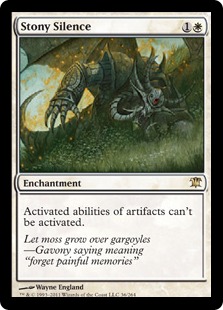
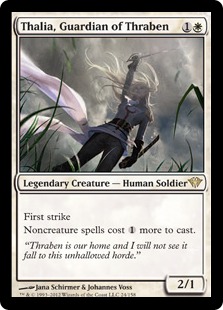
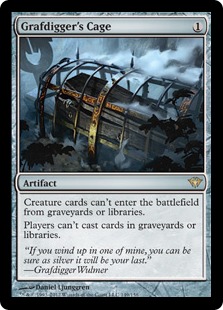 [/card]
[/card]

